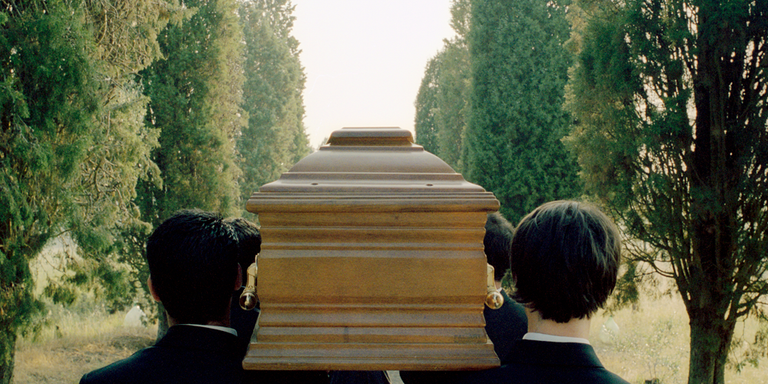
How to Plan an Eco-Friendly Funeral
by
by
5 min readMany of the elements of a traditional funeral come with an environmental impact—from embalming to cremation, and from cut flowers to huge limousines. Fortunately, there are many steps you can consider to help make a funeral and burial more environmentally friendly.
For starters: Our bodies are designed to biodegrade, but common burial practices throw a wrench in that process. When planning a funeral, consider these alternative approaches to body disposition:
Table of Contents
- Choose a sustainable and biodegradable casket.
- You may choose to skip the embalming.
- Support a green cemetery.
- Consider cremation.
- Look into water cremation.
- Use a natural grave marker.
- Request local flowers or trees planted in memory.
- Keep funeral programs greener.
- Serve local and organic food.
- Don’t use disposables at the meal.
- Carpool or eliminate driving.
Choose a sustainable and biodegradable casket.
Most of the caskets you’ve seen are full of metal, paint or varnish, polyester batting, and other materials that won’t break down quickly, if at all. Lessen your impact on the earth by choosing a natural wood casket made with tongue-in-groove joints—or a shroud of natural fabrics, which will readily biodegrade. Take it a step further by opting for a very sustainable material for a casket, such as fast-growing bamboo or woven willow.
You may choose to skip the embalming.
Embalming preserves a body for an open-casket viewing and funeral, but it also slows the decomposition process and adds carcinogenic chemicals to the burial site. And it’s not necessary. You can achieve short-term preservation with ice and refrigeration, or you can plan a memorial service without the body present to eliminate the need for preservation.
Support a green cemetery.
If you’re choosing burial with no embalming and in a biodegradable casket, a green cemetery is the perfect place to do it. These specialized burial grounds are reserved for natural burials. The bodies laid to rest there enrich the earth, rather than polluting it. Green cemeteries tend to be parklike or forested settings, where you can remember your loved one in the serenity of nature. And they’re maintained without the use of harmful pesticides and herbicides, often with soil-enriching native plants.
Consider cremation.
While cremation isn’t the absolute eco-friendliest option for body disposition, it’s much more environmentally responsible than the traditional U.S. burial, and it’s readily available everywhere. If other options don’t appeal to you or aren’t available near you, cremation is a great way to make a funeral greener.
Look into water cremation.
Water cremation, also called resomation or alkaline hydrolysis, is a newer body disposition alternative with minuscule environmental impact. The body is broken down using an alkaline liquid, and the result is a substance similar to cremation ashes but without the emissions created by burning. You can scatter, bury, or save them just like cremated remains. However, water cremation has only been legalized in certain states so far, and even in those, there aren't many facilities yet. You’ll need to do some research to determine if it’s an option for you.
Aside from these alternative burial practices, there are several eco-friendly actions you can take regardless of how the body may be handled.
Use a natural grave marker.
Although stone is a natural material, the process of creating a traditional headstone—having a piece of granite quarried, cut, polished and carved by machines—leaves a big carbon footprint. You can take a pass on this pollution by planting a tree or bush at your loved one’s gravesite instead of a headstone. If you choose cremation instead of burial, you can add a memorial planting to your own land and improve the air quality even as you commemorate your loved one.
Request local flowers or trees planted in memory.
Rather than cut flowers shipped long distances, help your funeral guests find locally grown flowers that are currently in season, by suggesting an eco-conscious grower or two in your area. Alternately, instead of sending sympathy flowers, you can have memorial trees planted in your loved one’s name. Through Legacy.com, well-wishers planted more than a million memorial trees last year—helping to beautify the earth, produce more fresh air, and reforest state and national lands.
Keep funeral programs greener.
Many funerals include printed materials, such as a program or mass card. One way to make these eco-friendly is to have them printed on recycled paper using soy or vegetable ink. Another option is to skip the printed funeral program altogether. The order of services can be projected from a laptop or read aloud as the service goes along.
Serve local and organic food.
If you’re planning a repast or reception with a meal or snacks, make it more sustainable by choosing local or regional foods. A memorable farm-to-fork dinner can be created with local and organic produce, meats, and cheeses.
Don’t use disposables at the meal.
Whether you’re serving a full meal at a repast or offering finger foods at a reception, you’ll make it more sustainable if you’re prepared to wash your tableware rather than throwing it away. Avoid plastic utensils, paper plates, and paper napkins in favor of silverware, ceramic plates, and linens.
Carpool or eliminate driving.
At many funeral services, friends and family drive their cars from the funeral location to the cemetery. Sometimes a long line of cars travels miles across a city in procession. There are several ways to make this greener. One is to arrange carpools for this procession, fitting as many people as possible into fewer cars. If possible, family and guests should drive their own cars rather than ride in gas-guzzling limos. Another option is to skip the long procession altogether: Hold the entire ceremony at one location and make the burial private for immediate family only, or plan for the entire service to take place at the graveside.
More resources:
TAGS




